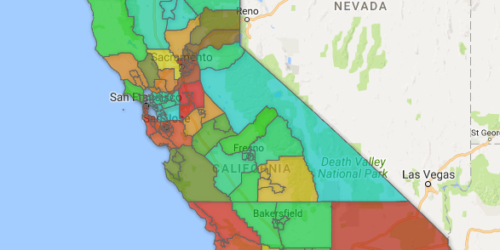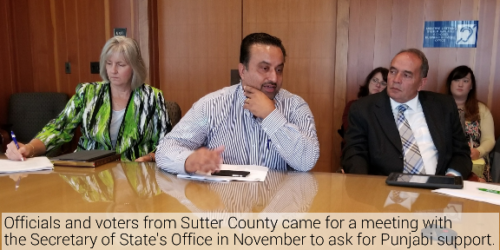Overview of Election Language Laws and Practices in California
Election laws in California provide a great deal of protections to minority language voters. These provisions, however, can be quite complex. It’s important for officials, as well as the public, to understand the relevant statutes and to observe carefully how they are carried out.
Demographics
Based on U.S. Census Bureau estimations, there are over 2.78 million low-English-proficiency (LEP) eligible voters in California. If the Census estimates are correct, then these eligible voters represent over 11% of the California electorate.
For a detailed look at minority language voter demographics, please see this companion demographics blog post or click through to the full demographic report:
Existing Protections For Minority Language Voters
Both federal and state law provide voting access protections to voters with low English proficiency in the form of both general and structured requirements placed on the administration of elections.
From a general directive under federal law, Section 2 of the Voting Rights Act (52 USC § 10301) requires that citizens be allowed to participate equally in all phases of the election process without regard to race, color, or membership in a language minority group. Additionally, Section 203 of the Voting Rights Act (52 USC § 10503) provides specific protections to some language minority groups based on certain population demographic determinations made by the U.S. Census Bureau.
Likewise, California law provides similar general and structured protections to minority language voters.
Elections Code section 2103(c) instructs that:
(It is) the intent of the Legislature that non-English-speaking citizens, like all other citizens, should be encouraged to vote. Therefore, appropriate efforts should be made to minimize obstacles to registration by citizens who lack sufficient skill in English to register without assistance.
Elections Code section 12303(b) similarly instructs, replacing “registration” with “voting,”
It is the intent of the Legislature that non-English-speaking citizens, like all other citizens, should be encouraged to vote. Therefore, appropriate efforts should be made to minimize obstacles to voting by citizens who lack sufficient skill in English to vote without assistance.
Elections Code section 2300, the Voter Bill of Rights, provides:
(Voters) have the right to election materials in another language, if there are sufficient residents in (their) precinct to warrant production.
Similar to the federal structured scheme, Elections Code sections 12303 and 14201 provide for demographic determinations to be made by the Secretary of State and local elections officials, and for materials and assistance to be provided at certain thresholds.
While similar, the differences in the two structured models are outlined here:
| Elections Code §§ 12303 and 14201 |
Voting Rights Act Section 203 |
|
| Who is covered for protection? | Any minority language group | Minority language groups of Hispanic, Asian, or Native American heritage |
| What triggers coverage?
|
3% or more of voting age resident population in any county or precinct that is of the same minority language group and low English proficient, or if sufficient information is provided by interested citizens or organizations to give reason to believe there is a need for assistance. | 5% or more, or numbering over 10,000, of voting age citizen population in any county that is of the same minority language group and low English proficient. |
| Who makes determination? | Secretary of State (§ 14201) and local elections officials (§ 12303) | U.S. Census Bureau |
| What materials and assistance are provided in target language for minority group? | Facsimile (photocopy) ballot aids (§ 14201); Bilingual pollworker recruitment (§ 12303); Voter Bill of Rights posters (§ 14105.3). | Ballots; assistance; ballot access; all election materials and forms; bilingual pollworkers; candidate filing; public notices; and registration cards. |
Historical Compliance And Present Practices
Two systems of compliance
While California law does refer to the federal Section 203 requirements in certain places, it largely doesn’t contain implementing provisions for the federal protections, and instead leaves the method and form of compliance with federal law to the individual jurisdictions. And so, there are counties in which Section 203 structured provisions are in effect, counties where Section 12303/14201 structured provisions are in effect, counties where both are in effect (for different languages), and counties with no language-specific requirements.
Of note, California law does not exclude protection of any minority language groups based on ancestry, national origin, or race, whereas federal law excludes Middle-Eastern, Slavic, and European languages from protection under its structured Section 203 determinations (but obviously not under the general protections of Section 2).
And so, there exists some jurisdictions where if elections officials only adhere to the minimum structured requirements of Section 203 (and ignore the general requirements under federal and state law), language minority groups with an identified need may not receive the same level of access to elections as a language minority of a different race, ethnicity, or national origin with the same or less of an identified need. This has occurred in practice, and continues to persist, in at least the following example instances:
- In Los Angeles County, Section 203 requires a range of language services to be provided to Khmer (Cambodian) speaking low English proficiency voters, including voter registration, translated ballots and materials, candidate filing, and bilingual assistance. This requirement is triggered in Los Angeles County because the Khmer speaking LEP population is about 12,000 people. In contrast, Section 203 does not require the provision of those services to a language minority such as Armenian (because of national and ethnic origin exclusions). The LEP Armenian population in Los Angeles County is estimated to be around 56,000 people, or five times the number of Khmer speakers.
- Statewide, voter registration forms and assistance are provided in Hindi, serving an estimated LEP population of 15,733 eligible voters. Voter registration forms are not provided in Armenian (61,577 LEP statewide), Persian Farsi (54,267 LEP statewide), Russian (47,983 LEP statewide), or Arabic (32,575 LEP statewide).
State law history
In 1894, in a bout of anti-immigration sentiment, the California Constitution was amended to include an English literacy requirement for voter eligibility. This requirement remained in effect for over 70 years.
But in 1970, the California Supreme Court ruled in Castro v. State of California that the English-only literacy requirement violated the equal protection clause of the Fourteenth Amendment. (2 Cal.3d 223 (1970) 466 P.2d 244 85 Cal. Rptr. 20)
After Castro, the modern facsimile ballot requirements in California were first implemented with the passage of AB 1469 in 1971 (McAlister, Ch. 1093, Stats. 1971).
The 1971 law required every precinct in the state to have and provide to voters facsimile ballots in Spanish. It additionally required facsimile ballots in other languages if there was a significant and substantial need found by the responsible county elections official.

In 1973, with the passage of AB 790 (Garcia, Ch. 885, Stats. 1973), counties were required to recruit bilingual pollworkers and deputy registrars of voters in precincts where 3% of the voting age residents were of the same minority language group and low-English-proficient. For bilingual pollworkers, the requirement and threshold from this bill remains in law today.

After the passage of the amendments to the Voting Rights Act in 1975 added the federal Section 203 minority language protections, and along with an update to the organization of the Elections Code, an exception to the facsimile ballot requirements was added by the passage of AB 3196 (Ch. 220, Stats. 1976) for counties required to provide ballots under Section 203.

And finally, the requirements for facsimile ballots were significantly altered in 1982 by the passage of AB 742 (Filante, Ch. 373, Stats. 1982). And aside from a reorganization of the elections code in 1994, there have been no changes to the facsimile ballot laws since the 1982 bill.

From 1983 onward, Spanish facsimile ballots were no longer required in every precinct but instead only in counties and precincts that the Secretary of State determined was appropriate, with similar determinations for other languages.
Statewide compliance
In recent practice, the Secretary of State has contracted with UC Berkeley to review census data estimates and make determinations on a precinct by precinct basis of how many eligible voters there are in each precinct and how many of those eligible voters have low English proficiency and are members of a specific list of minority language groups. The Secretary of State has then published the number of precincts in each county that are required to provide facsimile ballots in each language based on the determinations and transmitted a listing of those specific precincts to each county. In 2013, for the last set of determinations, the Secretary of State decided to only include a language minority group in the determinations if elections assistance was already provided somewhere in the state for that language under Section 203 requirements.
This scheme may fail to meet the requirements under Elections Code section 14201 for the following reasons:
- The law requires that the Secretary of State must also, in addition to looking at the demographic ratios, consider if interested citizens or organizations provide the Secretary of State with information which gives the Secretary of State sufficient reason to believe there’s a need for the furnishing of facsimile ballots in a precinct or county, and the current practice does not allow for this.
- The law does not allow for the Secretary of State to only include some language minority groups in the determinations.
- The law requires the Secretary of State to make determinations at the precinct level; however, the estimates prepared by UC Berkeley are based on data models that do not provide fidelity at the granular level required of precinct-by-precinct determinations.
A number of counties fail to provide facsimile ballots to voters for use inside voting booths as required under the law (See: Voices of Democracy: The State of Language Access in California’s November 2016 Elections. Asian Americans Advancing Justice LA). A number of counties fail to post facsimile ballots in determined precincts. Counties vary in their advertisements and promotion of facsimile ballot availability. For the facsimile ballots themselves, there isn’t a uniform template or prescribed method for producing the facsimiles. Production timelines vary from county to county.
The Secretary of State has not in recent practice maintained a program for ensuring uniformity or compliance with the language determinations at the local level, does not perform audits or request reports about compliance with the language determinations, and does not update the determinations in response to changes in precinct geographies.
Conclusion
There are strong protections found in California law for language minority voters. There are also a great deal of resources and effort expended by elections officials throughout the state to ensure that they both meet the requirements of the law and provide good voting experiences for their communities. Still, there will always be room for improvement, and so it’s important to look at the deficiencies and find ways of resolving the issues.






